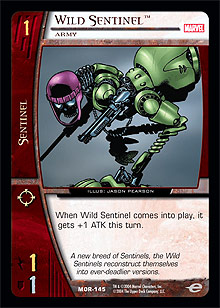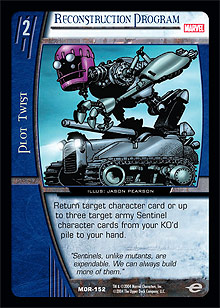When Vs. System was first released in 2004, there was a lot of excitement surrounding the game. The full suite of comic book heroes hadn't been in a trading card game for several years, and UDE had collected both the Marvel and DC licenses; within months, players and their X-Men decks could square off against Batman's Gotham Knights. The first set released was Marvel Origins, which featured the X-Men and their mortal enemies the Brotherhood, as well as the Fantastic Four and their nemesis Dr. Doom. Some legendary characters such as Apocalypse made it in as well. All of these teams were high-level, high-profile teams at the first $10K at Origins, showing up in decks such as Big Brotherhood, Doom control, FF Toys featuring Fantasticar, and Mutant Nation.
 And then there were the Sentinels.
And then there were the Sentinels.
The robots had been placed into the set as a sort of mini-team. Unlike the other teams, who had a full roster with four or so characters at each drop, the Sentinels had received only one character at every cost except 1 and a small suite of plot twists. Not only that, but the Sentinels were also generally small for their costs, with a 2 ATK / 2 DEF on turn 2, a 4 ATK / 3 DEF on turn 3, and a 5 ATK / 6 DEF on turn 4. They were Army characters, so you could run as many as you wanted to make up a complete deck, and power-ups could abound with the extra named characters, South American Sentinel Base, and Reconstruction Program. But it was clear they were mostly for fun—they weren't meant to compete with the heavy hitters in Marvel Origins.
But Michael Thicke, and later many, many others, would soon come to see the light. Michael had the inspiration to combine unknown cards with more unknown cards and create a good deck. The specific card that Michael found was Longshot, Rebel Freedom Fighter, affectionately known as “The Mullet.” Longshot's ability was typically long odds—with an average deck, it was nearly impossible to draw cards with his ability—but if you were to, say, take two Army characters and put fifteen, twenty, or twenty-five copies of each of them in your deck, you could make Longshot's long odds much shorter. (Isn't that what Longshot is supposed to do?) And once you did that, wouldn’t cards like Cover Fire become really, really mean?
At the time, this was radical thinking. All four main teams appeared to be designed for curve decks. FF Toys, Big Brotherhood, Doom control, Mutant Nation—all of these decks wanted to play an X-drop on turn X and never miss. The only deck that was an exception to this was The New Brotherhood, and that usually played an on-curve drop for four turns out of five, skipping out of the curve only to abuse TNB. Sentinels had no TNB, and thus no apparent reason to go off-curve. After all, why would you spend your turn 3 playing some 2 ATK / 1 DEF characters—who would be 1 ATK / 1 DEF on the next turn—when you could just play a 5 ATK / 5 DEF Thing, Ben Grimm or a 6 ATK / 6 DEF Wolverine, Logan and get to both keep that power on the table and keep two more cards in your hand? And what happened when you got to turn 6? You'd be playing a decent-sized Sentinel Mark IV, but it wouldn't keep up with a 12 ATK / 12 DEF character when all you'd have left were more 1 ATK / 1 DEF Sentinels. The deck seemed like suicide.
As always, though, the Sentinels had a few tricks up their metal sleeves.
 While Michael's list has been lost to the mists of time, here's a typical list, played at Pro Circuit Indy by Metagame.com's own Rian Fike:
While Michael's list has been lost to the mists of time, here's a typical list, played at Pro Circuit Indy by Metagame.com's own Rian Fike:
Wild Vomit
PC: Indy 2004
24 Wild Sentinel
12 Sentinel Mark IV
4 Senator Kelly
4 Longshot, Rebel Freedom Fighter
4 Cover Fire
4 Reconstruction Program
4 Search and Destroy
4 Underground Sentinel Base
Rian finished in 19th place with this list at PC: Indy 2004 on the back of a 5-2 Day 1 record.
Along with being one of the easiest decks in history to record on a decklist, this deck is interesting for two reasons. First, Wild Vomit shows how innovative deckbuilding can take you to unexpected places. These high finishes wouldn't have happened without innovation and guts. This deck was completely off-the-wall at the time. Decks that play differently than your average deck are very difficult for opponents to play against. Many players know all the right moves against the popular decks, but when you bring something strange like Wild Vomit to the table, your opponent is likely to make play mistakes against it simply because they have no experience with it.
Also, more importantly, Vomit takes advantage of cards that wouldn't work nearly as well in any other strategy. Abusing a particular card is a hallmark of good deckbuilding in general, but it's more pronounced in this deck than in any other deck in the history of the game.
 Take Reconstruction Program as an example. In any “normal” deck, Reconstruction Program brings back a character from the KO'd pile, which is a fine application. Quite a few decks ran the card just for that, in fact. But in this deck, Reconstruction Program is frequently an It's Clobberin' Time! that works on defense. The card goes from a semi-playable trick to a hugely powerful combat plot twist.
Take Reconstruction Program as an example. In any “normal” deck, Reconstruction Program brings back a character from the KO'd pile, which is a fine application. Quite a few decks ran the card just for that, in fact. But in this deck, Reconstruction Program is frequently an It's Clobberin' Time! that works on defense. The card goes from a semi-playable trick to a hugely powerful combat plot twist.
The rest of the cards in Wild Vomit are the same way: mediocre in other decks, but ridiculously good in this one. Essentially, Longshot let you have two draw steps in a turn. Underground Sentinel Base let you have two recruit steps. Cover Fire turned into Last Stand with no drawbacks. Senator Kelly left Golden Archer in the dust when it came to burn, and Search and Destroy made Terra, Tara Markov look silly.
This deck demonstrates just how good cards can get when they're played in a way that fully maximizes their potential. This deck takes a few cards that aren't broken in any sort of normal deck and breaks them, as consistently and powerfully as possible. How do you make Longshot draw cards on most activations? By running as many copies of the two named cards as possible. How do you make Underground Sentinel Base as good as possible? By making sure that the robots it brings out are as large as possible. How do you maximize Reconstruction Program? By making sure the cards it's bringing back from the KO'd pile have as many applications as possible. How you do maximize Cover Fire and Senator Kelly? By making sure every character in your deck (except Senator Kelly) has range, and then go off curve and play as many characters as you can. Wild Vomit was all about doing unusual things in as unfair a way as possible.
This lesson has not gone unlearned. Think back to PC: San Francisco, when the deck of the moment was the Justice League of Arkham deck, known as Ivy League. That deck was a textbook example of this principle. Ivy League did an unusual thing—it could make your opponent discard a card before their resource step—and then it did that unusual thing in the most unfair way it could, making for one of the more powerful and unusual decks in the history of Vs. System.
When attempting to abuse a card, you have to be careful about what cards you're using to maximize your specific card. The cards should be independently useful and not just enablers for your particular card unless you are certain you're going to hit your card every game. For instance, you don't see cards like Clocktower in here. Yes, it can help you hit your Longshots with greater consistency, but that's really all it does. It doesn't have enough of an effect on the game otherwise. What if you don't draw Longshot, or the opponent manages to KO him? You have a nearly worthless card in your deck. Play cards that work well together, not just enablers.
Cards that you can abuse this way are all over the place. One of my favorites is from an older set: Qwardian Pincer from Green Lantern Corps. I have gotten this card up into the +6 ATK to +8 ATK range in Draft, and into the +10 ATK or greater range in Manhunter decks in Constructed. I was very close to actually playing a Manhunter deck at PC: Indy in 2005, and certainly would have if Chopping Block hadn't been in every deck. Qwardian Pincer would have been a four-of, and Plans Within Plans for another Pincer was a win condition.
Ah, memories.
These open-ended cards are made in every single set. Look at Banished to the Abyss, for instance. If you want to brickwall someone in Marvel Team-Up, look no further than this card. There are a lot of ways to exhaust a character, and quite a few more to ready one. In Limbo is another. Just how many characters can you keep stunned, and just how many In Limbos can you get into your resource row? Both Scandal and Powell search for ongoing plot twists, to name two. You can also run Morlun for a walking In Limbo, and Underworld has plenty of cards to put extra characters into play stunned. These are the cards you need to look out for when building that rogue deck.
When World's Finest comes out, take a hard look at the open-ended cards and unusual plays, the Longshot, Rebel Freedom Fighters, the Cover Fires, Qwardian Pincers, and In Limboes. If you want to build a rogue deck to abuse a particular card, these are the cards you will want to abuse. And don't be afraid to look at the things a team, or a card, isn't supposed to do. For instance, what is Team Superman's best card? A considerable argument could be made that it's actually Kandor, which affects exactly one character named Superman. Nobody expects the off-curve Supes deck, and if they don't expect it, they'll make mistakes. Every mistake your opponent makes takes you one step closer to the City Championship title, and every time your deck does what it’s supposed to do, you should get a warm “attack for 23 with Manhunter Guardsman” feeling inside.
Until next time,
Mark Slack
ms243 -at- evansville -dot- edu